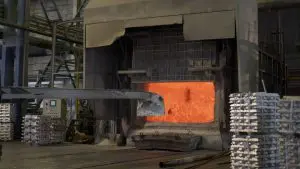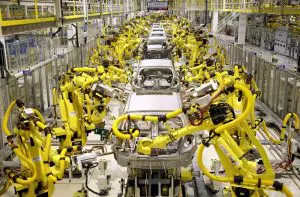The first die casting machine came into existence in 1838, which was a manually operated device. It used an alloy of tin and lead for casting letters. There were further iterations in 1846 and 1886 which had an integrated die casting machine. These poured liquid lead into the line molds with brass letter dies.
Die casting was limited to the printing industry for the first few decades until Herman H. Doehler unveiled the Doehler Die Casting Company in the year 1908. It manufactured die-cast parts and was a market leader until 1998.
It was in 1925 when we first got the glimpse of what a modern die casting machine can look like, which was developed by Louis H. Morin and Joseph Soss in the USA. Since then, we have seen several breakthroughs in this industry with machines becoming more powerful and efficient in due course.
In this article, we discuss the basics of die casting.
Table of Contents
What is the die casting process?
Die casting is an automated process of melting alloys (usually those with low melting points) into liquid state and pressing them under high pressure into molds. A pressure of about 150 to 1200 bars is used with a filling speed of 540km/hr.
The process differs from sand casting in the aspect that metal molds are used which can be reused.
Die casting comprises four different processes – die preparation, filling, ejection, and shakeout. For the first part, the operator sprays a lubricant (water-based is the most common, but manufacturers use water-in-oil or oil-in-water too) over the mold cavity. It ensures keeping the temperature in control and easy removal of the finished product.
Post lubrication, the die gets sealed, and the molten metal passes through the pipes at a high pressure of 1,500 to 25,400 psi. The pressure level remains intact until the liquid solidifies and takes the shape of the cast.

Once the solidification is complete, the operator opens the cast, and the ejector pin removes the shot. The last step, i.e. shakeout, involves separating the scrap from the finished product. The manufacturer can use sawing, grinding, or other relevant processes to free the cast from the gate, sprues, flash, and runners.

The scrap is separated and can be melted for reuse, which leads to the yield being close to 67 percent.
Once the shakeout is complete, the finished product is tested for misruns, cold shuts, or any other possible defects.
The process
There are two different processes used in die casting – hot chamber and cold chamber. To begin, the mold is brushed/sprayed with a release agent to ensure easy removal after the process is complete. Irrespective of the process in use, the liquid first passes through a casting chamber where a piston presses it into the mold through single or multiple channels.
Tooling for die casting
Two parts mainly form a die casting – one is cover die half, and the other is the ejector die half. Both of them meet at the parting line. The former contains the sprue or shot hole, allowing the metal to travel to the die. The latter has the ejector pins, and the runner which comes in between the cover die half and the mold cavity.
The cover die attaches to the platen of the machine located at its front. The ejector die stays with the movable platen. Also present are two cavity inserts, which are bolted into the die halves and are easily replaceable.
Manufacturers design the dies in such a way that the finished product will stay in the ejector half after the process is complete. The ejector pins, driven by a pin plate, ejects them and retracts back to their original position.
Cores and slides also form a part of the machine. The former creates holes or other specific designs and can be fixed, loose, or movable, depending on the need. Slides function similar to movable cores and are useful in undercutting the surface.
Types of die casting machines
Following are the types of die casting machines that find usage in different circumstances –
Hot chamber die casting machine
In a hot chamber die casting method, the liquid passes through the valve into the chamber and is pressed at high speed into the mold by the piston. Here the chamber is in constant contact with the liquid metal and the casting set is placed within the melt.
In this process, the operator immerses the injection machine in the metal liquid. A gooseneck attaches the machine to a metal feed system. The die is then closed, and the piston rises to open the port, allowing liquid to fill the container.
Cold chamber die casting machine
In cold chamber die casting method, the casting equipment is placed outside the melt. The casting chamber uses channels to press the liquid into the mold. The process is best suited for alloys with a high melting point.
Here, the metal is first converted into liquid in a separate furnace. The operator then transfers the same to the casting machine and feeds it in the chamber. The machine then pushes a pressurized plunger to force the liquid into the cavity.
Low-pressure die casting
Mostly used for aluminium components, the low pressure die casting involves the mold placed vertically above the molten metal bath, and a riser tube connects them. Because of the pressure, the liquid is pulled in the mold, and the non-existence of feeders ensures high yields.
High-pressure die casting
In high-pressure die casting, the metal liquid is injected at high speed and high pressure in the mold. It results in a cast that has superior surface finish, uniform, and high precision.
Vacuum die casting (VPC)
A relatively new variation known for achieving low porosity and high strength, the vacuum die casting is similar to low-pressure die casting. Here the location of the mold and the molten metal bath is interchanged, and the chamber creates a vacuum, forcing the liquid into the cavity.
Squeeze die casting
The squeeze die casting is appropriate for liquids with low fluidity. It is mostly used for aluminium and aids in fiber replacement.
Semi-solid die casting
Also known as Thixoforming, the semi-solid die casting is useful in delivering high precision casts. It offers minimal porosity and maximum density.
Advantages and disadvantages of die casting
Following are the pros and cons while using a die casting machine.
Advantages
- Higher yield because the molten metal is injected at a very high speed in the dies.
- Ability to attain the finish of order of 1.1 microns conveniently.
- Lower waste material generation.
- The mold is reusable ensuring lower scrap.
- High accuracy and repeatable reproduction of different complexities because of the presence of moving parts.
- Die-casting parts can be created with close adherence to given specifications.
Disadvantages
- It isn’t easy to cast low-fluidity metals.
- Most casting processes will result in a small amount of porosity in the finished dies. Some of them need additional treatment to ensure sustaining cracks or exfoliation.
- The setup is limited to a maximum weight which prevents casting for all sizes and requirements.
- If there is air trapped inside the cavity, it can lead to defects.
- It is economical only when you set it up for large-scale production.
Die casting materials
There are four primary alloys that we usually find useful for die casting – aluminum, magnesium, copper, and zinc.
Apart from having specific characteristics, these offer good corrosion resistance, high strength, and high thermal and electrical conductivity, making them an apt choice.
Also, these are non-ferrous, and their composition ensures excellent flexibility in terms of usage. Most die cast alloys are fully recyclable and can withstand high temperature with ease.
Uses of die casting- fields of application
Most manufacturers opt for die cast when they want to manufacture homogeneous products on a large scale. A good casting ensures that the quality doesn’t deteriorate during the manufacturing process.
The die casting application is most suitable for producing very thin items (newspapers, alloy sheets, etc.).
Because of their ability to maintain quality over some time, they find usage in a myriad of industries, with automotive and press being the most common.
Also, the following industries are known to use die cast for its production purposes –
- Furniture
- Electronics
- Machinery
- Lighting technology
- Power tools &
- Aerospace
Defects in die casting
Here are the probable flaws that may bug you during die casting –
- Flashing issues because of injection pressure being too high or clamp force being below par.
- Creation of bubbles because of non-uniform cooling rate or injection temperature being high.
- Hot tearing is caused because of uneven cooling rate.
- Ejector marks on the casting caused because of high ejection force or cooling time being too short.
- Unfilled sections because of slow injection, low pouring temperature, or insufficient volume.
Conclusion
The modern-day die casting industry is a highly competitive one. The European counterparts are struggling to match with their Asian competitors, specifically China and India. The whole industry is trying hard to improve the manufacturing process and achieve a scrap rate of zero percent.
With digitization 4.0, the vehement integration of digital technologies and processes which offer better efficiency and control, we expect the industry to flourish and reach new heights. The future of die casting revolves around the ability to create novel products with high clamping force and a variety of usage.
At EKO, we offer precision die casting that is made possible because of the deployment of the latest technology phenomenon and ensuring that the processes are optimized to make use of them efficiently. We offer a plethora of surface finishing for every product that comes out of our machines and offer customization such as laser engraving, tempo print, and others.
Learn more about die casting in our follow up articles:



